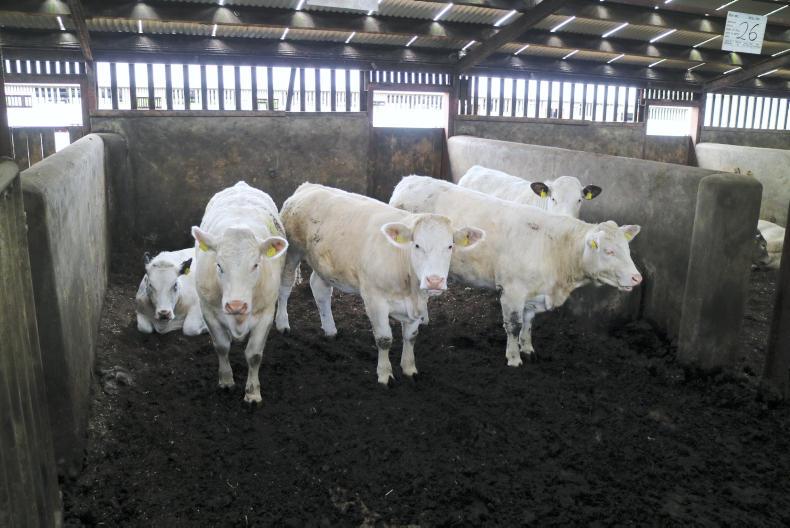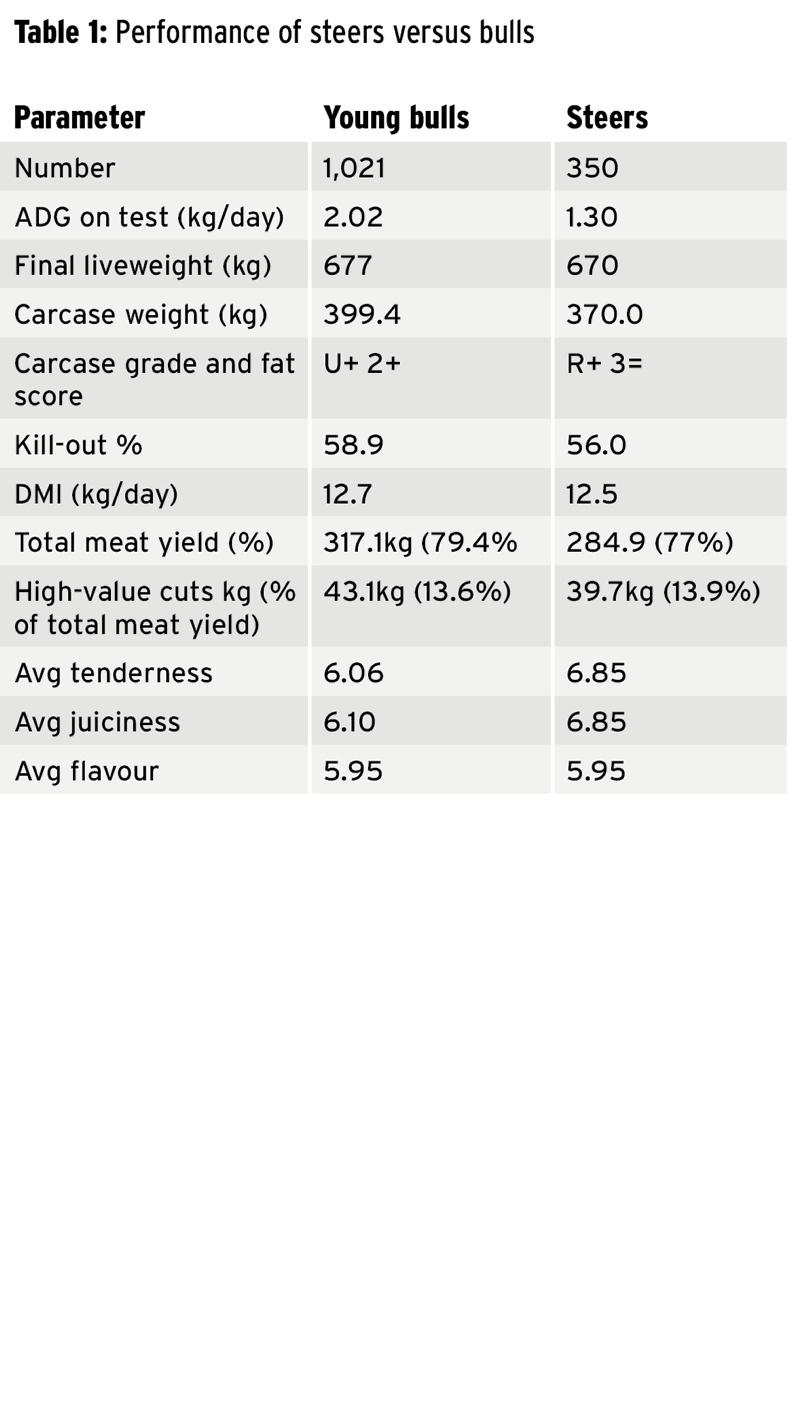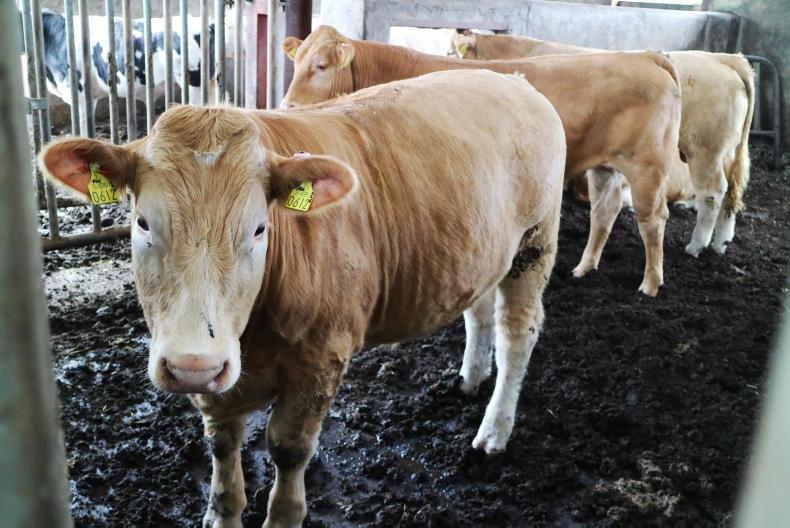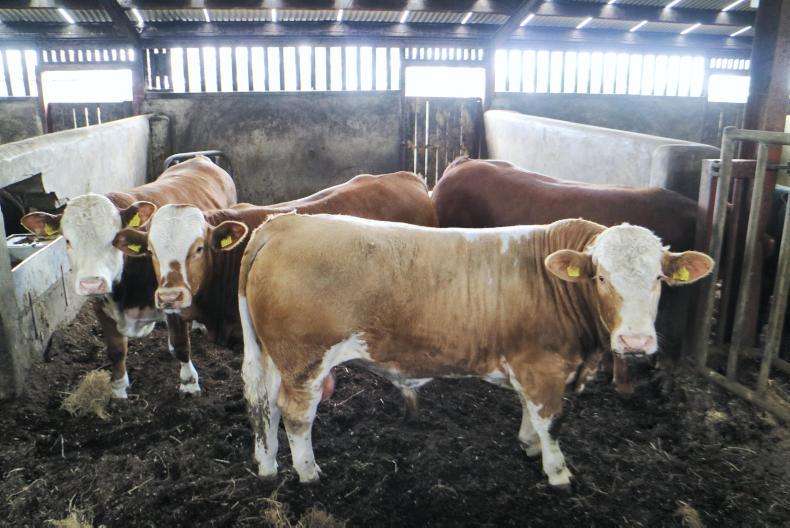Young bulls achieved higher performance in each production parameter measured with steers only bettering bulls in the meat quality traits of tenderness and juiciness.
The tests were carried out at ICBF’s test centre in Tully.
The results, presented by manager Stephen Conroy, include data from 1,021 young bulls and 350 steers finished in the last two to three years.

This pen of heifers contains three Charolais crosses, a Simmental cross and a Belgian Blue cross. Their weights range from 422kg to 462kg with heifers recently transferred on to their finishing diet.

As can be seen in Table 1, bulls achieved a significantly higher daily liveweight performance over the finishing phase. Conroy told those attending that the average liveweight figure of steers detailed in the table has been improved to between 1.4kg and 1.5kg in the current intake following a tweak in the finishing diet. Steers are being offered 10kg concentrates, along with 3kg hay fresh weight while bulls are finished on an ad-lib diet.
The slightly lower feed input of steers compared with bulls (an average of 12kg concentrate per day) could be viewed by some as leaving the steers at a slight disadvantage in terms of daily liveweight gain but looking at the data analysed there was very little difference in the total dry matter intake. The lower concentrate level offered to steers was also targeted at achieving the best balance of liveweight gain and avoiding animals going overfat at a younger age.
Leaving daily performance aside, Conroy’s analysis shows bulls excelled in terms of carcase weight, carcase weight and fat score, kill-out percentage and total meat yield.
On meat quality factors measured, there is no discernible difference between the percentage of carcase comprising high-value meat cuts.

This LZF Charolais cross steer was born on 27 February 2016 and currently weighs 536kg with an average dry matter intake of 11.92kg dry matter.
As mentioned earlier, steers did achieve higher performance than bulls in the measurement of meat tenderness and juiciness with the measure of average flavour similar across bulls and steers.
Looking at the implications of this information at farm level, it is little surprise that those operating intensive finishing systems opt for bulls rather than steers.
Management required in finishing bulls is more precise than steers, especially if incorporating a second grazing, but those that can manage it are currently winning out with price returns on a similar platform to steers, without taking into account the production benefits.

The front Simmental bull was sired by AGC and was born on 5 February 2016. He has a replacement index value of €121.91 and weighed 644kg with an average daily gain of 2.13kg and dry matter intake of 9.7kg. The Limousin cross bull in the middle was sired by YOB, born on 19 March 2016 and has a replacement index of €128.44. He weighed 598kg having gained 1.74kg liveweight daily, consuming 9.16kg dry matter. The Hereford cross bull on the left was sired by GPZ and born on 21 February 16. He weighed 604kg with an average daily gain of 1.98kg and intake of 10.32kg.
The implications of increasing the percentage of bulls in the weekly kill above current levels is something that is continually reiterated by factories as having the potential to negatively affect market access but in the absence of a higher premium for steers it is hard to see these producers changing system.
Huge differences
The aim of the evaluations carried out in Tully is to collect information on commercial progeny from AI sires and use this data to identify the best-performing sires while also continually validating indexes. It is not surprising therefore that there are differences in performance between sires on an across and within breed basis.
For example, Conroy highlighted bulls gaining from as little as 1.2kg over the finishing phase to a 2.5kg daily liveweight gain or higher.
The difference in performance backs up predicted performance on the terminal index.
Table 2 details the performance of young bulls on their star rating.

Daily liveweight performance did not differ on average but five-star bulls finished five days earlier than three-star bulls and 15 days earlier than one-star bulls.
A significantly higher kill-out in five-star animals also resulted in a carcase weight difference of 10kg and 14kg with three- and five-star bulls, respectively.
Our feed costs in Tully are about €3 per day
“If we factor in an average of finishing bulls 15 days shorter, it has the potential to add €45 to the bottom line.
“Taking a beef price at €4/kg, the benefit in a higher carcase weight is worth about €56 when comparing one- and five-star bulls.
“The two of these combined could leave you with a higher return of about €100 per head. It also backs up the potential performance farmers can achieve in using five star bulls,” stated Conroy.
While meat quality is not currently factored into the index, the measurements of meat tenderness, juiciness and flavour are all moving in the right direction.
Evaluating heifers
The Tully test centre is now also evaluating heifers with the first intake currently in place. The management of animals can be viewed by watching the video from last week’s event.
Watch: dairy crosses not the answer for suckler herd